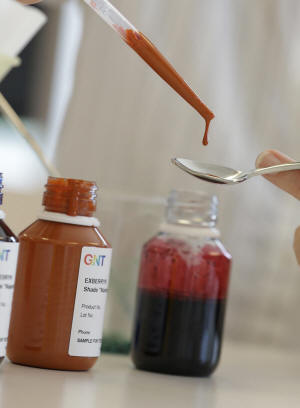States move to ban or restrict use of synthetic dyes used in candies and
cereal
[March 27, 2025]
By LEAH WILLINGHAM
CHARLESTON, W.Va. (AP) — Synthetic dyes used to make brightly colored
cereals, drinks and candies are coming under scrutiny in states across
the country, where lawmakers say the federal government has stalled in
taking action despite evidence of harmful effects.
West Virginia, which ranks at the bottom in the U.S. for many health
metrics, became the first to sign a sweeping statewide ban on seven such
dyes this week. Lawmakers in more than 20 states — from deep red West
Virginia to heavily Democratic California — are making a bipartisan push
to restrict access to the dyes, which have been tied to neurobehavioral
problems in some children and of which U.S. Health and Human Services
Secretary Robert F. Kennedy Jr. has been an outspoken critic.
“We should not be forced to police our own foods,” said Republican Sen.
Laura Wakim Chapman, who heads the Senate's health committee and told
lawmakers the vote might be the most important of their political
careers. “No more toxic colors, no more poisoning ourselves and our
children. No more unnecessary risks. Our health is not for sale."
In signing the bill, Republican Gov. Patrick Morrisey referenced
Kennedy's slogan in saying, “There’s no better place to lead the Make
America Healthy Again mission."
The prohibition on certain preservatives and red, blue, green and yellow
dyes takes effect for school food in August, and across the state in
2028. It follows narrower bills approved in California last year and
Virginia last week that would ban six artificial dyes from being served
in public schools beginning in 2027.
Why do lawmakers want to see the dyes die?
Thirty-six color additives are approved by the Federal Drug
Administration for use in food and drinks in the U.S. Nine
petroleum-based chemical dyes, including Red 3, have been allowed in
U.S. food.
Public health advocates have been lobbying for state and federal action
for years, pointing to research that links food dyes and other chemical
additives to health risks, including exacerbating symptoms of
attention-deficit/hyperactivity disorder in some children and animal
research linking certain additives to cancers.

The European Union and some countries, including Australia and Japan,
have banned or restricted the use of certain food dyes because of
potential health risks.
In October, dozens of protesters outside the Michigan headquarters of WK
Kellogg Co. demanded that the company remove artificial dyes from
cereals such as Apple Jacks and Froot Loops. Kellogg announced that it
would remove artificial colors and ingredients from its U.S. products by
2018, but never did so, despite making the change in other countries,
such as Canada, where Froot Loops are colored with concentrated carrot
juice, watermelon juice and blueberry juice.
The U.S. Food and Drug Administration banned Red 3 from the nation’s
food supply in January, setting a 2027 deadline for manufacturers to
eliminate it from their products. Makers of ingested drugs like cough
syrups have until January 2028.
[to top of second column]
|

In this photo from July 29, 2015, a GNT employee deposits carrot
extract on to a spoon at their offices in Tarrytown, N.Y. (AP
Photo/Seth Wenig, File)
 Food industry warns of cost
increases
The National Confectioners Association, a trade group for chocolate,
candy, gum and mints sellers, said the new regulations will make
food more expensive, less accessible and lead to less variety on
grocery store shelves. It said states such as West Virginia, where 1
in 4 children live in poverty and many neighborhoods are “food
deserts” with limited access to affordable, nutritious food, will be
disproportionately impacted.
Charles Leftwich, vice president of food safety and quality
assurance for Sysco Corp., the world’s largest food service
distributor, said food safety policies should be supported by
science and “be consistently applied across all geographies.”
“We shouldn’t have a fragmented approach when it comes to food
safety, because it breeds a lack of trust and confidence with within
consumers,” Leftwich said in an interview with The Associated Press.
Changes underway
School districts in West Virginia have begun phasing out breakfast
cereals, strawberry milk or other products in anticipation of the
new law's August deadline.
Chris Derico, who runs Harrison County's school nutrition program,
expects the new regulation to increase costs but said he's not “in
panic mode about it” because none of the products containing the
artificial dyes are used in main dishes served to students.
Travis Austin, who leads food service in the Cabell County Schools
system, called the policy “a step in the right direction” and said
it will be up to manufacturers to rework their formulas to remain
competitive.
“It’s all about money,” he said. “If Froot Loops and Lucky Charms
aren’t going to change their formulations, then we’re not going to
buy them. We’ll buy ones that do.”
Lawmakers in West Virginia, which leads the nation in chronic
diseases such as obesity, noted that the dyes are often found in
sugary foods.
When the bill passed the state Senate, sponsor Jason Barrett said
West Virginia was the first state to approve such a sweeping law but
won’t be the last. He cited a bill advancing in Oklahoma that would
ban 21 synthetic food dyes and additives.
He said companies prey on low-income consumers and children.
“With passage of this bill, we are saying to big food corporations
that the health of our people comes first,” he said.
All contents © copyright 2025 Associated Press. All rights reserved |